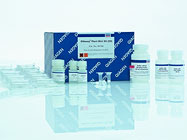
Qiagen’s DNeasy Plant DNA Extraction Mini Kit is a widely used kit in molecular biology labs for the routine extraction of genomic DNA from a range of plant material. I only use the DNeasy kit when I require relatively small amounts of genomic DNA for genotyping purposes using PCR. Several protocols exist which use simple salt buffers such as Tris-EDTA and can generate higher yields of DNA. These are commonly used for downstream applications where larger quantities of DNA are required, such as DNA-DNA hybridization platforms. The problem with these methods is they require several ‘wash and spin’ steps to precipitate clean DNA and get rid of cell debris in the form of polysaccharides, proteins and salts. The DNeasy kit makes it easier to generate clean DNA which is important for PCR applications, since salt contamination can hinder the efficiency of DNA amplification and primer specificity. The main drawback for me using the DNeasy kit is that I have repeatedly generated very small yields of DNA from a relatively large initial sample. However, these yields (3 – 8 ug of DNA) are sufficient for my downstream genotyping application which makes the DNeasy kit suitable for my needs.
In our lab, the primary starting material for the DNeasy Plant Mini Kit is Arabidopsis thaliana leaf tissue. We have used the kit with varying degrees of success using different starting materials. It seems to work fine with frozen cell cultures but gives lower yield with tough tissue high in cellulose and pectins. The kit recommends a variety of methods to prepare the sample prior to cell lysis. I personally freeze leaves immediately in liquid nitrogen, and then grind to a fine powder in the cold (to avoid the tissue from thawing during homogenization) in a 2 ml eppendorf tube using a plastic tip grinder. It is possible to directly add the lysis buffer to fresh leaf samples, and in some cases this has resulted in higher DNA yield. In my hands, the DNeasy kit works best with about 80 mg of homogenized Arabidopsis leaf tissue. Tissue lysis appears to be a problem in this kit, and I repeatedly have samples with bits of leaf tissue that refuse to lyse in solution. This occurs with about 15% of any given sample set, which significantly affects the efficiency of the kit. A 10 minute incubation at 65°C sometimes eases the lysis of leaf tissue, and this often requires gentle agitation during the incubation. The protein and polysaccharide precipitation step in this protocol works quite efficiently and I have had no problems with the contamination of these macromolecules in my final eluates. The kit then introduces two columns, the first of which shreds the samples further to release DNA from the nucleus, and the second which binds the DNA to allow the flow-through of salts and other unbound material in the reagents and sample. The DNA is then washed with ethanol and related wash buffers, after which it can be eluted in Tris buffer or sterile water. I personally prefer using sterile water. In my experience, 50 ul elution volume is sufficient to obtain a reasonable quantity of DNA. I often do the elution as a two-step process, the first elution with 30 ul and the second with 20 ul to collect in the same tube. This can consequently be quantified and checked for integrity on the Nanodrop.
Research Associate
Dept of Biological Sciences
Royal Holloway University of London